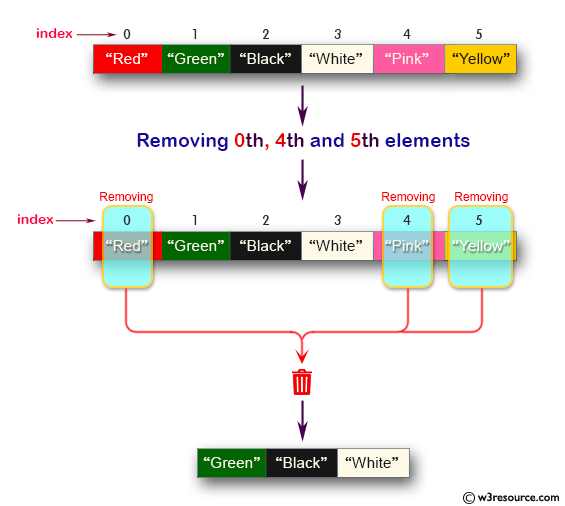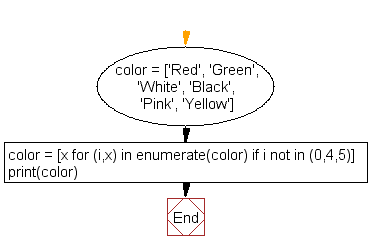Python: Print a list after removing specified elements
Remove Specific Elements from List
Write a Python program to print a specified list after removing the 0th, 4th and 5th elements.
Visual Presentation:

Sample Solution:
Python Code:
# Create a list 'color' with several color strings
color = ['Red', 'Green', 'White', 'Black', 'Pink', 'Yellow']
# Use a list comprehension to create a new list 'color' that includes elements from the original list
# but only if their index (i) is not in the specified indices (0, 4, 5)
color = [x for (i, x) in enumerate(color) if i not in (0, 4, 5)]
# Print the modified 'color' list, which excludes elements at indices 0, 4, and 5
print(color)
Sample Output:
['Green', 'White', 'Black']
Explanation:
In the above exercise -
color = ['Red', 'Green', 'White', 'Black', 'Pink', 'Yellow'] -> Creates a list color containing some color names.
color = [x for (i,x) in enumerate(color) if i not in (0,4,5)] -> Creates a new list using a list comprehension. The list comprehension loops over each element (i, x) in color and includes only those elements where i is not in (0, 4, 5).
After this code runs, the list color will only contain the elements that have an index of 1, 2, or 3. So, the colors 'Green', 'White', and 'Black' will be included, and 'Red', 'Pink', and 'Yellow' will be removed.
Flowchart:

For more Practice: Solve these Related Problems:
- Write a Python program to remove elements at even indices from a given list.
- Write a Python program to remove elements that contain a specific substring from a list of strings.
- Write a Python program to remove every third element from a list.
- Write a Python program to remove elements whose length is greater than 5 from a list of words.
Go to:
Previous: Write a Python function that takes two lists and returns True if they have at least one common member.
Next: Write a Python program to generate a 3*4*6 3D array whose each element is *.
Python Code Editor:
What is the difficulty level of this exercise?
Test your Programming skills with w3resource's quiz.
